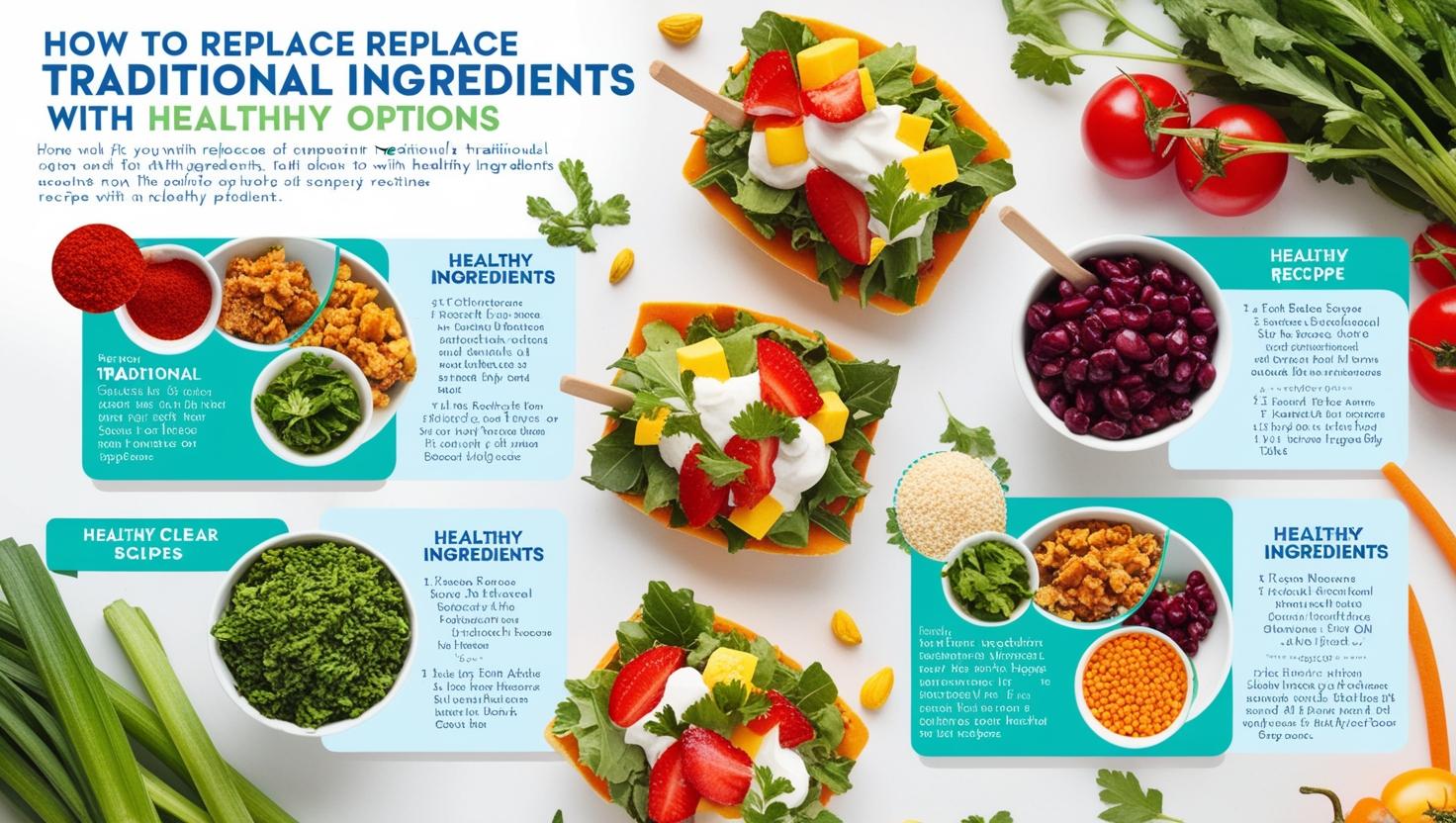In today’s fast-paced world, maintaining a healthy diet is more crucial than ever. One effective strategy to achieve this is by substituting traditional ingredients with healthier alternatives in your favorite recipes. This approach not only enhances the nutritional value of your meals but also introduces exciting flavors and textures. Let’s explore various ingredient swaps that can transform your cooking into a healthier culinary adventure.
1. Replacing Refined Sugars
Excessive consumption of refined sugars has been linked to numerous health issues, including obesity and diabetes. Fortunately, there are natural sweeteners that can serve as excellent substitutes:
- Honey: A natural sweetener rich in antioxidants, honey can replace sugar in baking and beverages.
- Maple Syrup: With its unique flavor, maple syrup is an excellent alternative in pancakes and desserts.
- Coconut Sugar: Derived from coconut palm sap, it has a lower glycemic index compared to regular sugar.
Tip: When substituting liquid sweeteners like honey or maple syrup for granulated sugar, reduce the overall liquid content in the recipe to maintain the desired consistency.
2. Switching Out Refined Flours
Refined white flour lacks essential nutrients due to the removal of bran and germ during processing. Consider these nutrient-dense alternatives:
- Almond Flour: Gluten-free and rich in protein, it’s perfect for baking cakes and cookies.
- Oat Flour: High in fiber, oat flour adds a mild, slightly sweet flavor to baked goods.
- Whole Wheat Flour: Retaining the grain’s natural nutrients, it’s a healthier substitute for all-purpose flour.
Tip: When using alternative flours, you may need to adjust the liquid ingredients to achieve the desired batter or dough consistency.
3. Opting for Healthier Fats
Traditional cooking often relies on saturated fats like butter and lard. Healthier fat options include:
- Olive Oil: Rich in monounsaturated fats, it’s ideal for sautéing and salad dressings.
- Avocado: Mashed avocado can replace butter in baking, providing moisture and healthy fats.
- Coconut Oil: Suitable for baking and cooking, it adds a subtle coconut flavor.
Tip: When substituting oils for solid fats in baking, consider the impact on texture and flavor, and adjust other ingredients accordingly.
4. Dairy Alternatives
For those who are lactose intolerant or seeking plant-based options, there are numerous dairy substitutes:
- Almond Milk: A versatile milk alternative suitable for drinking, cooking, and baking.
- Cashew Cheese: A creamy, dairy-free cheese alternative perfect for spreads and sauces.
- Coconut Yogurt: Provides a rich texture and is excellent in smoothies or as a snack.
Tip: Plant-based dairy alternatives can vary in flavor and consistency, so choose the one that best fits your recipe’s requirements.
5. Meat Substitutes
Reducing meat consumption can lower saturated fat intake and promote heart health. Consider these protein-rich alternatives:
- Tofu: A versatile soy product that absorbs flavors well, suitable for stir-fries and grilling.
- Chickpeas: Rich in protein and fiber, they can be used in salads, stews, and even mashed as a spread.
- Lentils: High in protein and iron, lentils are excellent in soups, salads, and as a ground meat substitute.
Tip: When substituting legumes for meat, season them well to enhance their flavor and mimic the savory taste of meat.
6. Reducing Sodium Intake
Excessive sodium can lead to hypertension and other health issues. Enhance flavor without relying on salt by using:
- Herbs and Spices: Basil, oregano, cumin, and paprika can add depth and complexity to dishes.
- Citrus Juices: Lemon or lime juice can brighten flavors and reduce the need for added salt.
- Vinegars: Balsamic, apple cider, or red wine vinegar can provide acidity and enhance taste.
Tip: Experiment with spice blends and fresh herbs to discover new flavor combinations that reduce the necessity for salt.
7. Healthier Snack Options
Traditional snacks like chips and candies are often high in unhealthy fats and sugars. Swap them for nutritious alternatives:
- Air-Popped Popcorn: A whole-grain snack that’s high in fiber and can be seasoned to taste.
- Nuts and Seeds: Almonds, walnuts, and chia seeds provide healthy fats and protein.
- Fruit Slices: Fresh or dried fruits offer natural sweetness and essential vitamins.
Tip: Prepare snacks in advance to avoid reaching for less healthy options when hunger strikes.
8. Baking Modifications
Baked goods can be made healthier by making simple ingredient swaps:
- Applesauce: A great alternative to butter or oil, reducing fat content while adding natural sweetness.
- Greek Yogurt: Adds protein and moisture, replacing heavy cream or sour cream.
- Mashed Bananas: An excellent replacement for sugar and fat in baked goods.
Tip: When substituting fats or sugars in baking, adjust the liquid ratios to maintain the right texture and consistency.
Conclusion: Transform Your Meals with Healthier Choices
Eating healthy doesn’t mean giving up on delicious meals. By making small ingredient swaps, you can enjoy your favorite dishes while boosting their nutritional value. Whether you’re looking to cut down on refined sugars, replace unhealthy fats, or find better protein sources, these simple changes can make a big difference in your health and well-being.
The best part? You don’t have to sacrifice taste! Many of these alternatives enhance the flavors and textures of your meals, making them even more enjoyable. So, why not start today? Experiment with these substitutions, discover new flavors, and take control of your health—one recipe at a time! 🚀🥗
Would you like any further refinements or additions to the article? 😊
